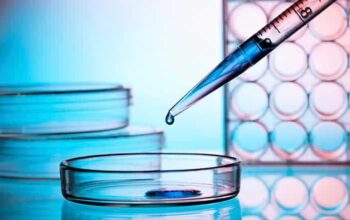The recent exploration of bio-nano circuits has unveiled extraordinary insights about the capabilities of bacteria, presenting an alternative to conventional metallic wiring systems. The fascination with microbial life forms has intensified as researchers amass evidence of their proficiency in conducting electricity, a characteristic traditionally attributed to metals like copper and gold. This revelation challenges long-standing paradigms in materials science and nanotechnology, positioning microbes as potential harbingers of innovative electrical conduction methods.
An exemplar of this phenomenon can be observed in the genus Geobacter, a group of microorganisms that thrive in anaerobic conditions. These bacteria possess the remarkable ability to transfer electrons outside their cells through a network of conductive pili—hair-like appendages that can effectively function as nanowires. This electron transfer process allows Geobacter to facilitate the reduction of metal ions, a mechanism that denotes their capability not only in bioremediation but also in bioenergy applications.
Furthermore, the conductive properties of these microbial nanowires stem from their unique biological composition. Composed primarily of proteins that can form metallic-like conductive networks, these pili manifest extraordinary electrical properties. Studies have intimated that the electron transport through these structures occurs via quantum tunneling, a principle wherein electrons ‘leap’ across potential barriers, hinting at a convergence between biological systems and quantum physics. The implications for the design of bio-inspired materials are profound, suggesting an avenue wherein nanoscale circuits could be fabricated using living materials rather than synthetic processes.
Moreover, the efficiency of energy conversion processes inherent to these bacteria raises pertinent questions regarding sustainability and environmental impact. Contemporary electronic devices are predominantly fabricated from resources that are environmentally taxing to extract and process. In stark contrast, harnessing microorganisms may minimize ecological footprints associated with electronic manufacturing. The prospect of bio-manufactured circuits offers a sustainable methodology, potentially revolutionizing the electronics industry by creating circuits that are inherently biodegradable and less reliant on landfill disposal after the end of their life cycle.
A significant avenue of research focuses on the manipulation of bacterial genetic composition to enhance their conductivity. Synthetic biology enables the reengineering of these microorganisms to optimize their electrical properties or to produce larger quantities of conductive nanowires. Furthermore, hybrid systems that integrate biological and artificial components could leverage the strengths of both realms. For example, by creating biohybrid devices comprising bacterial nanowires and conventional electronic components, researchers can push the boundaries of what is achievable in terms of miniaturization, efficiency, and versatility.
The application of bacterial nanowires extends beyond mere conductivity; they can potentially interface with electronic stimuli in unprecedented ways. One of the most promising applications lies in the development of biosensors capable of detecting environmental pollutants or biological markers. As the bacteria respond to various stimuli, the changes in their electrical conductivity could be harnessed to produce real-time feedback regarding the presence of specific substances. This capability could offer significant advancements in public health monitoring and environmental assessments.
However, there exist considerable challenges that must be navigated before the widespread adoption of bacterial nanowires in electronic applications. The long-term stability of these biological materials in technological contexts remains a pertinent issue. Unlike metals, which exhibit predictable behaviors under varying conditions, bio-based components may suffer degradation over time due to environmental factors or microbial competition. Advanced encapsulation technologies and stabilization methods are critical to ensuring the longevity and reliability of these biocompatible circuits in practical applications.
In the realm of telecommunications, the lightweight and flexible nature of bio-nanocircuits may inspire breakthroughs in wearable technology. As societal demands shift towards more integrated and unobtrusive electronic devices, bio-inspired materials possess distinct advantages; their adaptability may facilitate the seamless incorporation into fabrics, skin, or other substrates. This could herald a new epoch of devices that are not only intelligent and responsive but also harmoniously integrated into daily life, ultimately enhancing human interaction with technology.
Moreover, the intersection of nanotechnology and microbial research prompts an important reevaluation of bioethics. As we contemplate the manipulation of living organisms for technological advancements, it becomes essential to address potential ecological and ethical implications. Striking a balance between innovation and responsibility must remain at the forefront of discussions within both scientific and societal contexts. Ensuring that these methodologies adhere to environmental standards and ethical guidelines is paramount as the field continues to evolve.
In conjunction, the burgeoning interest in nanowire technologies elucidates further the intricate interplay between biology and electronics. It provokes curiosity, inviting interdisciplinary collaboration among biologists, material scientists, and electrical engineers. The exploration of bacterial nanowires as a viable alternative to traditional electrical components signifies a transformative approach to technology and environmental sustainability, propelling humanity toward a future where biological insights reshape technological landscapes.
In conclusion, the investigation of bacterial wires is not merely a scientific endeavor but a transformative journey towards reimagining material applications. The convergence of bio-engineering and electronic innovations promises a shift in how we perceive and utilize natural resources, potentially redefining the boundaries of our technological capabilities while addressing pressing ecological concerns. Indeed, as the research in this field continues to blossom, it will undoubtedly lead to novel applications that may rival, if not surpass, existing metallic solutions in myriad domains.










